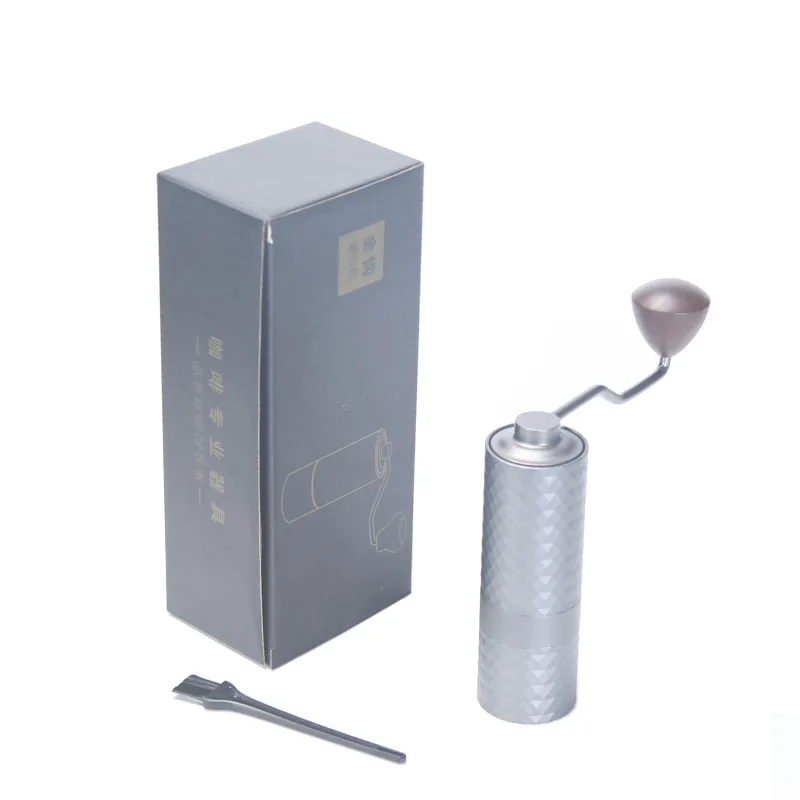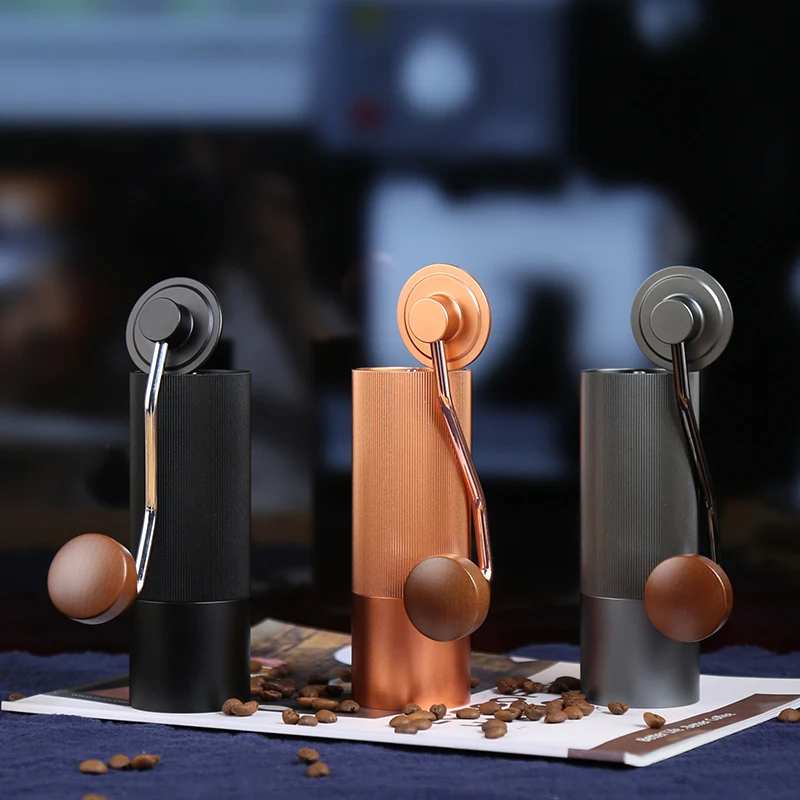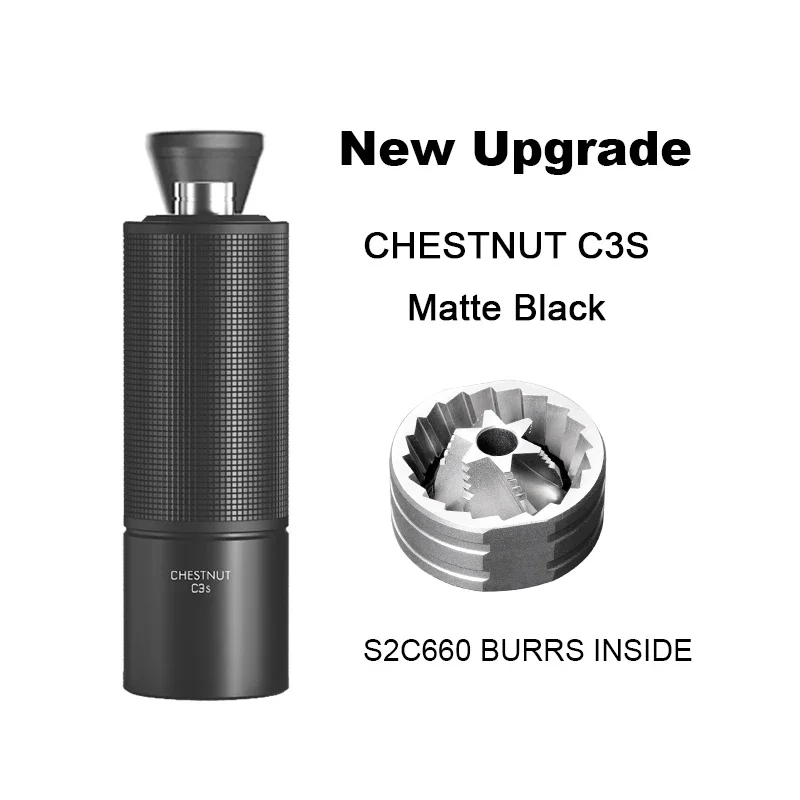Introduction
There’s something deeply satisfying about the ritual of manually grinding coffee beans. The steady turning of the handle, the subtle resistance as beans transform into grounds, and the emerging aroma that signals the start of a perfect brew. For coffee enthusiasts who cherish this connection to their brewing process, the choice of grinder makes all the difference – and increasingly, serious coffee lovers are turning to all-metal manual coffee grinders as their tool of choice.
All-metal manual grinders represent the pinnacle of grinding technology in many ways. These precision instruments offer a compelling package of durability, consistency, and quality that directly translates into better-tasting coffee. From their robust construction to their precision engineering, these grinders preserve flavor, maintain performance, and provide a premium experience that plastic alternatives simply cannot match.
In this article, we’ll explore the numerous advantages that make all-metal coffee grinder designs stand out from the crowd. The material choice in your grinder isn’t just about aesthetics – it fundamentally affects grind quality, user experience, and ultimately, the flavor in your cup. Understanding why choose all-metal coffee grinder options can transform your daily brewing ritual from ordinary to exceptional.
What Defines an “All-Metal” Manual Coffee Grinder?
An all-metal manual coffee grinder is exactly what the name suggests – a hand-operated grinding device constructed primarily or entirely from metal components. Unlike hybrid designs that incorporate plastic or ceramic elements, these grinders maximize the use of metals throughout their construction for superior performance and longevity.
Key metal components typically include:
- Outer housing/body: Usually constructed from aluminum, stainless steel, or other durable metals
- Burr set: Precision-cut stainless steel or hardened steel with specialized coatings
- Central shaft/axle: Metal core providing stability and alignment
- Handle and crank mechanism: Metal construction for durability and smooth operation
- Adjustment mechanism: Metal components for precise and consistent settings
- Catching container: Often metal in premium models, sometimes glass in hybrid designs
The combination of these metal elements creates a synergistic effect where each component supports the others, maintaining precise alignment and consistent performance over time. This stands in stark contrast to models that may incorporate plastic elements in critical areas like the burr mounting system or adjustment mechanism.
The best material coffee grinder choices often depend on specific needs – stainless steel offers corrosion resistance, aluminum provides lightweight strength, and titanium components deliver exceptional durability with minimal weight. Each material brings its own advantages to the grinding experience.
The Exceptional Durability and Longevity of Metal Construction
Perhaps the most immediate and obvious benefit of an all-metal grinder is its remarkable durability. These grinders are built to last, often becoming prized possessions that accompany coffee enthusiasts through years or even decades of daily use.
Metal construction excels at handling the physical stresses of coffee grinding:
- Resistant to impacts and accidental drops that would crack or shatter plastic bodies
- Maintains structural integrity under the pressure applied during grinding
- Withstands the constant torque and mechanical forces without warping or flexing
- Resists the degradation that can occur from exposure to coffee oils and cleaning products
Understanding stainless steel coffee grinder durability reveals why these tools often outlast their plastic counterparts by years or even decades. While a typical plastic-component grinder might need replacement in 2-5 years with regular use, quality all-metal grinders frequently serve their owners reliably for 10+ years, making them excellent long-term investments.
This exceptional toughness also makes all-metal grinders ideal travel companions. Whether packed in a suitcase, camping backpack, or taken on international coffee adventures, they withstand the rigors of travel without fear of damage. Many coffee enthusiasts find that long manual coffee grinders last through countless journeys while maintaining consistent performance in any environment.
Superior Grind Consistency Through Structural Stability
When it comes to brewing exceptional coffee, grind consistency is absolutely critical. Uneven grounds extract at different rates, leading to muddled flavors where some particles over-extract (creating bitterness) while others under-extract (creating sourness). This is where the structural advantages of all-metal grinders truly shine.
The superior rigidity of metal components creates several key benefits:
- Metal housing prevents flex during grinding that would cause burr misalignment
- Precise metal mounting systems keep burrs perfectly centered and calibrated
- Solid metal axles eliminate wobble that causes inconsistent particle size
- Metal construction maintains tighter manufacturing tolerances for precision parts
These structural advantages translate directly to what’s in your cup. When beans are ground with consistent particle size, extraction happens uniformly, allowing the full flavor potential of your coffee to emerge with clarity and balance.
Understanding why coffee grinder not consistent performance occurs often traces back to material choices. Plastic components can flex under pressure, causing the burrs to shift slightly during grinding. This creates a mixture of fine and coarse particles that extract unevenly. Metal’s rigidity eliminates this problem, delivering uniform grounds that extract evenly for better flavor.
Premium Metal Burrs: The Cutting Edge of Grinding Performance
At the heart of any quality coffee grinder are the burrs – the cutting mechanisms that transform whole beans into grounds. In all-metal manual grinders, these crucial components benefit from premium materials and precision engineering.
High-quality metal burrs offer several distinct advantages:
- Hardened steel maintains sharpness through thousands of grinding sessions
- Precision-machined cutting surfaces create consistently sized particles
- Special coatings like titanium nitride enhance durability and smoothness
- Metal burrs resist damage from occasional foreign objects (like small stones)
- Higher precision manufacturing processes produce better cutting geometry
- Greater hardness allows for thinner, sharper cutting edges
The difference between ceramic vs steel grinder burrs is particularly notable. While ceramic burrs have their own advantages, steel burrs typically offer better durability against accidental damage and often provide more precise cutting action. They’re also generally more consistent in manufacturing quality, ensuring reliable performance.
For those seeking the ultimate grinding experience, exploring product-category/all-metal-hand-grinder options reveals how these precision components work together to deliver exceptional results cup after cup.

Enhanced Flavor Preservation Through Superior Thermal Management
Coffee beans contain hundreds of volatile compounds that contribute to flavor and aroma. These delicate compounds can be negatively affected by heat during the grinding process, leading to premature flavor degradation before brewing even begins.
All-metal grinders offer a distinct advantage in preserving these flavors through superior thermal management:
- Metal’s higher thermal conductivity dissipates heat away from the beans
- Heat generated by friction is quickly drawn away through the metal body
- Consistent temperature during grinding prevents uneven thermal effects on beans
- Reduced localized heating preserves volatile aromatics for better-tasting coffee
The impact heat retention metal coffee grinders have on flavor can be subtle but meaningful, especially for those pursuing the perfect cup. When grinding lighter roasts with delicate floral notes or fruit acidity, heat management becomes particularly important for preserving these nuanced flavors.
While some worry about whether can coffee grinders overheat, the thermal conductivity of all-metal designs generally prevents this problem compared to materials that might insulate heat around the beans. This advantage becomes more pronounced with longer grinding sessions or when preparing very fine grinds for espresso, where more friction generates more heat.
Simplified Cleaning and Enhanced Hygiene
Coffee oils and fine particles inevitably build up in any grinder over time. If not properly cleaned, these residues can become rancid, introducing off-flavors to fresh grounds and compromising the quality of your brew. All-metal grinders offer distinct advantages when it comes to cleaning and maintenance:
- Non-porous metal surfaces resist coffee oil absorption and staining
- Smooth metal finishes make wiping away residue simpler and more effective
- Quality metals resist corrosion from occasional moisture during cleaning
- Metal components can be thoroughly cleaned without fear of damage
- Fewer crevices where coffee particles can hide compared to some plastic designs
- Some designs can be partially disassembled for more thorough cleaning
For those seeking maximum convenience, product-category/stainless-steel-manual-coffee-grinders offer particularly excellent hygienic properties. Stainless steel naturally resists bacterial growth and doesn’t retain odors, making it an ideal material for coffee equipment that requires minimal maintenance while delivering consistent results.
A simple cleaning routine – brushing out grounds, occasional wiping with a dry cloth, and periodic deeper cleaning – keeps an all-metal grinder performing at its best year after year, maintaining the pure flavors of your favorite beans without unwanted contamination.
The Premium Tactile Experience and Aesthetic Appeal
Beyond performance advantages, all-metal manual coffee grinders deliver a premium sensory experience that enhances the coffee ritual. There’s an undeniable satisfaction in using a well-crafted tool that feels substantial and responds with precision to your movements.
The physical experience of using an all-metal grinder includes:
- Satisfying weight that provides stability during grinding
- Smooth rotation without the flexing or creaking of plastic components
- Balanced design that feels natural in the hand during operation
- Cool-to-the-touch sensation that connects you to the grinding process
- Visual appeal that showcases craftsmanship and attention to detail
These ergonomic features coffee grinders incorporate aren’t just about aesthetics – they directly impact the functionality and user experience. The added weight stabilizes the grinder during use, requiring less effort to hold it steady. The smooth action of quality bearings and precisely machined components makes grinding feel effortless rather than a chore.
Many coffee enthusiasts display their all-metal grinders prominently in their kitchen or coffee station, appreciating them not just as functional tools but as beautiful objects that reflect their commitment to quality coffee preparation.

Sustainability and Long-Term Value Proposition
In a world increasingly concerned with sustainable consumption, all-metal manual coffee grinders represent a responsible choice that aligns quality with environmental consciousness.
The sustainability advantages include:
- Dramatically longer product lifespans reduce waste from disposable products
- Durable construction eliminates the need for frequent replacements
- Many models offer replaceable parts, extending useful life even further
- No electricity required means zero energy consumption during operation
- High-quality materials maintain value and can often be recycled if ever needed
From a value perspective, the initial investment in a quality product-category/manual-coffee-grinder-stainless-steel quickly pays dividends. While the upfront cost may be higher than entry-level plastic grinders, the economics become compelling when considered over time. A quality metal grinder costing $150-300 used daily for 10+ years represents just pennies per use – a remarkable value for a tool that directly impacts every cup of coffee you brew.
This “buy once, cry once” philosophy ultimately delivers better coffee while generating less waste and costing less over time – a rare combination of personal and environmental benefits.
Comparing All-Metal Grinders to Alternative Constructions
While all-metal grinders offer numerous advantages, it’s worth comparing them directly to alternative constructions to understand where they excel and where other designs might have certain benefits.
Metal vs. Plastic Bodies:
Metal bodies provide superior durability, stability, and precision over time. They resist cracking, warping, and degradation from coffee oils and cleaning. The main trade-off is increased weight and higher initial cost. Plastic components may offer weight savings for travelers and lower entry price points, but typically compromise on longevity and stability.
Metal vs. Ceramic Burrs:
Metal burrs generally offer better durability against accidental damage (like encountering a small stone), while ceramic burrs sometimes provide longer edge retention under ideal conditions. Metal burrs tend to produce fewer fines (very small particles) at coarser settings, while some ceramic burrs excel at very fine settings. Each has its proponents, with metal generally offering better all-around performance and less susceptibility to damage.
Understanding the differences between metal plastic hand grinder construction helps coffee enthusiasts make informed decisions based on their specific needs and priorities. While all-metal construction represents the premium choice for most users seeking maximum durability and consistency, hybrid designs can sometimes offer compelling benefits for specific use cases like ultralight backpacking.
What to Look for When Choosing an All-Metal Manual Grinder
Not all all-metal grinders are created equal. Key factors to consider when selecting a quality manual grinder include:
- Metal selection: Stainless steel offers excellent corrosion resistance, while aluminum models provide lighter weight at the cost of some durability.
- Burr quality and design: Look for precision-machined burrs with hardened steel or specialized coatings for longevity.
- Bearing quality: Smooth operation depends on quality bearings that maintain axle alignment.
- Adjustment mechanism: Seek models with clear, consistent adjustment steps that maintain their setting during use.
- Manufacturing precision: Higher-end models offer tighter tolerances and better alignment.
- Capacity considerations: Match the grinder size to your typical brewing method and serving quantity.
- Ergonomics: Handle design and overall balance significantly impact user experience.
Fine Adjustment Hand Grinder, Precision Manual Grinder, Travel Coffee Grinder
Price range: $185.11 through $494.63 Select options This product has multiple variants. The options may be chosen on the product pageHand Burr Grinder, Hand Crank Coffee Grinder, Manual Espresso Grinder, Portable Coffee Grinder
Price range: $262.72 through $300.22 Select options This product has multiple variants. The options may be chosen on the product pageManual Burr Mill, Manual Coffee Grinder Stainless Steel, Manual Coffee Mill Grinder, Mechanical Coffee Grinder
Price range: $127.26 through $130.32 Select options This product has multiple variants. The options may be chosen on the product pageHand Burr Grinder, Manual Coffee Grinder Stainless Steel, Precision Manual Grinder
Price range: $183.64 through $187.52 Select options This product has multiple variants. The options may be chosen on the product page
For those seeking maximum precision, exploring product-category/precision-manual-grinder options reveals how manufacturers achieve exceptional grind consistency through attention to detail in these crucial areas.
Grinders with full metal manual coffee grinders construction generally offer the best performance, though some excellent models incorporate minimal non-metal components in non-critical areas while maintaining the essential metal structure for stability and durability.

Are There Any Downsides to Consider?
While all-metal manual coffee grinders offer numerous advantages, a balanced assessment should acknowledge potential considerations:
Weight: The substantial construction that provides stability during grinding also makes these grinders heavier than plastic alternatives. This could be a factor for travelers or hikers weighing options metal coffee grinders for portable use. Some manufacturers now offer specialized lightweight metal models that balance durability with portability.
Initial Investment: Quality all-metal grinders typically require a higher upfront investment than entry-level alternatives. This cost reflects the superior materials, precision engineering, and longer expected lifespan.
Temperature Sensitivity: Metal conducts temperature, making these grinders cold to the touch in winter months. Some users find this uncomfortable initially, though the grinder quickly warms during use.
Noise Considerations: All-metal designs can sometimes resonate more than plastic models, though the grinding noise itself is often described as more pleasant – a solid mechanical sound rather than a harsh plastic noise.
These considerations rarely outweigh the significant benefits for most users, but they’re worth understanding when making an informed purchase decision.
Is an All-Metal Manual Grinder Worth the Higher Price?
Given the higher initial investment required for a quality all-metal manual grinder, many coffee lovers reasonably question whether the price difference is justified. When analyzed objectively, the value proposition becomes compelling:
A premium product-category/manual-coffee-burr-grinders might cost $150-300, compared to $30-70 for basic models with plastic components. However, when distributed across a 10+ year lifespan of daily use, the cost per use drops to mere cents. Additionally, the consistent grind quality directly improves every cup of coffee brewed during those thousands of uses.
Consider also the frustration factor – inconsistent grinders that produce uneven results, develop wobble, or require constant readjustment create daily annoyance. The peace of mind and consistent quality from a well-made tool adds intangible but real value to your coffee routine.
Perhaps most importantly, grind quality fundamentally impacts extraction. Even the finest beans brewed with the most careful technique cannot overcome the limitations of inconsistent grinding. For coffee enthusiasts seeking to maximize flavor potential, investing in grinding quality offers perhaps the highest return of any equipment upgrade.
Conclusion: Elevating Your Coffee Journey With Precision Engineering
The benefits of all-metal manual coffee grinders extend far beyond simple durability. These precision instruments represent a perfect marriage of form and function, delivering performance advantages that directly translate to better coffee in your cup day after day, year after year.
From the structural stability that ensures consistent grind size to the thermal properties that preserve delicate flavors, metal construction enhances every aspect of the grinding experience. The premium tactile feedback connects you more deeply to the coffee preparation ritual, while the long-term durability makes these tools sustainable both environmentally and economically.
For those serious about their daily brew, investing in a quality all-metal grinder is not an extravagance but a foundation. It’s the critical tool that transforms great beans into great coffee, ensuring that your carefully selected roasts reach their full potential in every brew. The latest premium metal coffee grinders showcase how thoughtful engineering and quality materials combine to create tools worthy of the best coffee moments.
In the world of coffee, where quality is measured in minutes of enjoyment and moments of satisfaction, the right tools make all the difference. An all-metal manual grinder isn’t just a purchase – it’s an investment in better coffee experiences for years to come.







